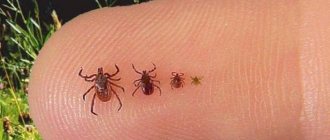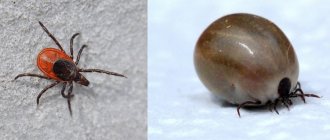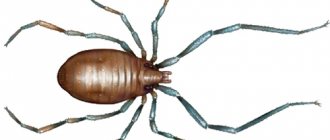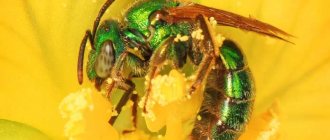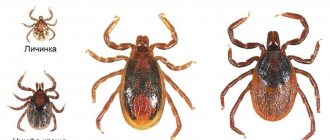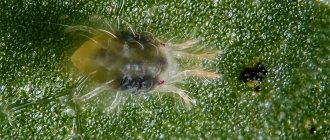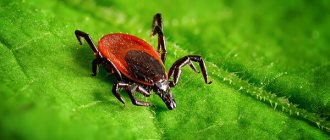Of course, there are ticks in Crimea. Several dozen species live here. But you shouldn’t resolutely refuse a trip to the sunny peninsula because of this. Firstly, because not all Crimean ticks are blood-sucking. Some of them are not interested in tourists and feed exclusively on grass juice. Secondly, there are ways to protect yourself from the negative consequences of encountering these arachnids or to avoid a dangerous bite altogether. In addition, in 2021, acaricidal treatments are carried out, as usual, throughout the peninsula in areas where these creatures are most numerous and active. In general, the likelihood of being bitten here is much lower than in most other regions of Russia.
What do Crimean ticks look like?
The term “encephalitis tick” does not refer to any one specific species of these arthropods. It only determines the state of infection of individuals of different species of ixodid ticks. Therefore, the appearance of dangerous bloodsuckers may vary slightly. All have a rounded dark brown or orange-brown body with 8 segmented legs. Hungry individuals are very small. These arthropods pose a danger at different stages of development: from larvae up to 0.5 mm in size to large adults that grow to a maximum size of 5 mm. Ticks that have drunk blood swell to 1.5–3 cm.
In Crimea you can meet European forest ticks and dog ticks, as well as Dermacentors - these are pasture, meadow species. With another grassland species, Haemaphysalis, which carries harmful microorganisms and viruses that cause tick-borne encephalitis. There is a possibility of suffering from steppe Hyalomma, carriers of Crimean hemorrhagic fever and other diseases.
Precautionary measures
In order to protect yourself, you should follow simple preventive measures:
- Get vaccinated against encephalitis. It can be done in almost any clinic.
- Wear a hat and a light jacket in the forest and forest park. Tuck pants into socks or boots. Or purchase a special anti-tick suit.
- Avoid walking in dense grass or bushes.
- Check yourself. Examine your body for ticks, comb your hair with a comb, carefully inspect your clothes and underwear - a tick could be stuck in the folds.
It is also useful to read: Immunoglobulin against tick-borne encephalitis
Where are ticks most often found in Crimea?
Their favorite places are where it is warm, quite humid, and there are many deciduous trees and bushes. But don’t be fooled: these creatures are active throughout the entire peninsula. You can meet them not only on a walk in the forest or in a city park. Different types of small bloodsuckers are found in the steppe regions. It is important to remember that encephalitis ticks appear not only in mountainous areas and foothills overgrown with tall grass, but also on some beaches. For example, active individuals were observed on Massandra beach in June. And in August they were spotted on the wild beaches of Feodosia. Therefore, even after sunbathing on a pebbly, rocky or sandy shoreline, it is important to carefully examine your body and clothing.
Basic prevention measures
Ticks in Crimea are active from the beginning of April to the end of October, most of them occur in May and September. People who live in rural areas, vacation in forest hotels and hospitals, tourists in forest and mountainous areas of the peninsula, pet owners, as well as those who walk in parks during the warm season are at greatest risk of getting their bite.
Ticks prefer shady clearings, densely overgrown with grass, bushy woodlands, and bright parks. They smell people and animals from a distance of up to 20 meters and capture body heat from half a meter. They can crawl following the scent of a potential victim, but more often they accumulate along roads and paths, lying in wait for people and animals on blades of grass. Therefore, it is better not to move along narrow paths where the grass constantly touches your feet.
Why are ticks dangerous in Crimea?
Blood-sucking ticks of different types can be infected with various dangerous microorganisms. It is impossible to visually determine whether a particular creature is a carrier of infection. When the skin with the saliva of an infected individual is bitten or when it is crushed, if removed incorrectly, harmful microorganisms can enter the circulatory system of the bitten person. In this case, the victim of a bite can become infected with tick-borne encephalitis, Lyme disease (borreliosis), tularemia, ehrlichiosis, Crimean hemorrhagic fever, anaplasmosis and other dangerous diseases.
Important! If you are bitten by a tick, it is very important to consult a doctor promptly. The first signs of tick-borne encephalitis can appear as symptoms of flu or a cold, then a short remission occurs, after which, in the absence of medical assistance, stages 2 and 3 occur. This affects the brain and internal organs. This can lead to disability, dementia or even death. Crimean hemorrhagic fever at the last stage is manifested by severe intoxication and numerous hemorrhages. This disease can also be fatal. Timely treatment will prevent terrible consequences.
Lyme disease
Every year, 50–70 people in Crimea become infected with borreliosis. The incubation period lasts 7–14 days. In most patients, a ring erythema appears at the site of the bite, reaching a diameter of 10 cm. A crimson, red spot bordered by a pronounced stripe protruding above the site of the bite. At the site of tick suction, itching and burning are felt for a long time. Some infected people have multiple hives-like rashes.
The first phase lasts 4–5 weeks. Symptoms of borreliosis:
- feverish condition;
- fast fatiguability;
- elevated temperature;
- muscle pain;
- redness of the eye sclera;
- drowsiness;
- rapid pulse;
- conjunctivitis.
As the disease progresses, arthritis, scleroderma, and skin atrophy appear.
Lyme disease responds well to antibiotic treatment. The most commonly prescribed drug is Doxycycline. If therapy is started in a timely manner, the course of treatment lasts 10 days.
If the region is endemic for borreliosis, doctors recommend taking Doxycycline for three days within 72 hours after tick ingestion. This will avoid the development of the disease, even if the tick became infected during the bite.
How to avoid becoming a “snack” for a tick
- Use old, long-tested advice. Wear light-colored clothing when hiking. A dark arthropod against a light background is easier to notice and remove in time before it has time to bite. In addition, on hot days, wearing light-colored clothes is simply more comfortable and cooler to move around in the Crimean heat.
- Conduct self-examinations regularly and carefully examine your comrades. Of course, it is not always convenient when hiking or on a tourist route to stop every two hours to carry out a thorough check. But even a cursory examination often helps to detect most of the arthropods that have entered the body.
- It is important to use repellents and acaricides before your hike and along the way. When choosing them, you need to make sure that the chosen product will really repel these creatures. The tick does not belong to the class of insects. Therefore, not all remedies work on these representatives of arachnids. It is better to choose specialized versions against ticks.
- The common advice to wear long sleeves and tuck your pants into your socks is actually not very good. A flat, small tick can get between layers of clothing. From the numerous tangled folds of fabric, he will not be able to get out and, most likely, will bite. These arthropods can be brought home unnoticed in the folds of clothing. Additionally, wearing too many layers of clothing slows down and complicates the inspection process.
- Upon returning home, it is important to carefully inspect and shake out your hiking clothes and backpacks. Ticks can enter your home with bouquets of flowers and herbs brought with you.
First aid for a bite
You don’t have to rely on luck; you need to know the rules for removing an animal from the surface of the body.
If you have a thread in stock, tie it around the tick's proboscis and pull gently, slightly rocking the body so that the head does not stick to the skin. Don’t forget to lubricate the wound with an antiseptic composition: medical alcohol, iodine, brilliant green solution. If you are unsure whether a tick was infected, take it to a laboratory for further examination.
One day I was removing a tick, but the proboscis came off. I had to pull it out with tweezers. Despite the measures taken, I was very afraid for my health: I regularly measured my temperature 3 times a day, sometimes it seemed that I was shivering and nausea was creeping up my throat. That time everything went well.
What to do if a tick still sticks
It is important to remove the embedded arthropod as quickly as possible before swelling begins around the bite. It will interfere with extraction. In addition, the longer his proboscis is in the wound, the greater the chance of contracting a dangerous disease. It is best if the tick removal operation is performed by specialists in a medical facility. But often such a bite is discovered on a hike, in the steppes, mountains and forests, in places where there is no medical help nearby. To prevent infection or minimize it, you will have to remove the attached creature yourself. To do this, they use different methods and available means. The arthropod can be pulled out using any suitable tweezers. Removal using a thread is more difficult, but it is important to remove the entire tick so that its mouthparts do not remain in the wound. Remains of arthropods in the wound can cause suppuration. To prevent this from happening, you can pick them out like a splinter. If there are no other ways to remove the tick, you can use vegetable oil or Vaseline, which is used to lubricate the bite site along with the embedded arthropod.
After removing it, the wound is disinfected with iodine or brilliant green. After this, it is important to consult a doctor. So that specialists can conduct research and, if necessary, prescribe the correct treatment, the removed tick must be packaged in a container with a tight-fitting lid, brought to a medical facility and submitted for analysis. Unfortunately, this doesn’t always work out during a hike. But even if it is not possible to examine the tick, the doctor will be able to draw important conclusions based on the general condition of the person who applied and how the bite wound looks.
Diseases carried by different types of ticks are extremely dangerous. But you shouldn’t despair and give up a wonderful holiday in Crimea for this reason. Statistics that have been kept on the peninsula for many years suggest that infection of people from the bites of these arthropods does not occur very often. It is only important not to neglect long-established, proven precautions that help prevent dangerous infection.
Risk level for humans
Tick diversity is not a reason to ignore Crimea. It’s a fact that encephalitis ticks are there, as are carriers of other dangerous diseases. But local health services record only a few cases per year for each disease, and not every year.
In general, Crimea is no more dangerous in terms of tick-borne indicators than the Moscow region. Data from sanitary and epidemiological stations show that among control individuals no more than a quarter are infected, and from 2 to 6% of them can transmit the infection. A mathematical calculation will show an extremely low risk level. All tick-borne diseases (despite the real danger and scary names) are completely curable. They are vaccinated against encephalitis, but it is not necessary when visiting the Crimean peninsula.
There are often recommendations to submit the removed tick to a laboratory to determine whether it is infected. The recommendation is dubious - this is a paid service, and how can you carry this bloodsucker with you along a tourist route? The possible risk does not justify such difficulties. But what should be done is to definitely go to the hospital if any painful symptoms appear within a few days (up to two weeks) after the bite. The initial stage of encephalitis is similar to a cold or flu. With timely treatment, any tick-borne disease will be quickly cured without consequences. But in advanced forms they are life-threatening. The doctor must be informed of the lesion.
But the tick is unpleasant even without encephalitis. It causes local inflammation with severe itching, and if it is not removed correctly and part of its proboscis remains in the body, the inflammation often continues for several weeks. Yes, this is not dangerous, but it interferes with enjoying life and will ruin your vacation at the resort.
